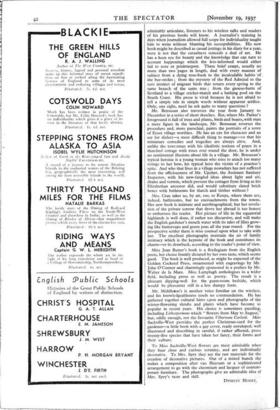THE COUNTRY LIFE
The Garden Book, an Anthology for all who love Gardens.
Collected by Anne Lamplugh. (Herbert Jenkins. 7s. 6d.) Winter-Flowering Plants for Outdoor Borders. Edited by
12s. 6d.) .
WE do not want to read 'about—and, therefore, authors de not write about—the things We have in plenty. They are
taken for granted until they begin to perish and grow scarce. No one bothered to collect and write down the folk-songs of
England while they were still sung in every village. When at length " civilisation " had supiilanted them with the factory- made article from the cities and they were preserved only
in the memory of the oldeit inhabitant, collectors got busy, societies were formed and singers exchanged, sometimes with odd results, their King's English for a peasant's dialect. Now this same force of civilisation is encroaching upon and modifying the life and customs of the countryman so rapidly that there remains little time to record them before they disappear. And since more and more of us are compelled by economic pressure to abandon the village for the town, there is a growing
interest, born of nostalgia, in the scenes that can only be visited at holiday-time and at fleeting week-end. Hine illi libri. Mr. Eric Parker is the country gentleman articulate. Host
admirably articulate, listeners to his wireless talks and readers of his previous books will know. A journalist's training in days when journalism allowed full scope for individuality taught him to write without blunting his susceptibilities. His new book might be described as casual jottings in his diary for a year, were it not that the casualness conceals a deal of art. He has a keen eye for beauty and the knowledge that can turn to account happenings which the less-informed would either fail to note or misinterpret. These brief essays, usually no more than two pages in length, deal with every manner of subject from a dying rose-bush to the incalculable habits 'of , the bee-orchis ; from the mystery of the Red Admiral to the sure instinct of migrant birds that return every spring to the same branch of the same tree ; from the grouse-butts of Scotland to a village cricket-match and a bathing pool on the South Coast. His prose is vivid because he is not afraid to tell a simple tale in simple words without apparent artifice. Only, one sighs, need he ask quite so many questions ?
Mr. Bensusan also traverses the year. from January to December in a series of short sketches. But, where Mr. Parker's foreground is full of trees and plants, birds and beasts, with man a mere figure _ in the landscape, Mr. Bensusan reverses the procedure and, more parochial, paints the portraits of a score of Essex village worthies. He has an eye for character and an ear for dialect—a most difficult thing to manage—so that his miniature comedies and tragedies are always alive. And, unlike the towrsman with his idealistic notions of peace in a thatched cottage with roses ever round the door, he is under no sentimental illusions about life in a village. Mr. Bensusan's typical heroine is a young woman who tries to attach too many strings to her bow, his typical hero the victim of a poacher's spite. And who that lives in a village nowadays has not suffered from the officiousness of Mr. Upcher, the Assistant Sanitary Inspector, with his new-fangled ideas about light and air, drains and vermin, which prevent the cottager from living as his Elizabethan ancestor did, and would substitute slated brick boxes with bathrooms for thatch and timber without ?
Mrs. Cran takes us, by air, too, to Kenya, where there are, indeed, bathrooms, but no encroachments from the towns. Her new book is intimate and autobiographical, but her revela- tion of the private sorrow that drove her abroad is too honest to embarrass the reader. Her picture of life in the equatorial highlands is well done, if rather too discursive, and will make the English gardener's mouth water with its tales of lilies grow- ing like buttercups and green peas all the year round. For the prospective settler there is wise counsel upon what to take with her. The excellent photographs maintain the air of family intimacy which is the keynote of the book and constitutes its charm—or its drawback, according to the reader's point of view.
Miss Joan Rutter's book is a florilegium from the English poets, her choice frankly dictated by her own taste, which seems good. The book is well produced, as might be expected of the Golden Cockerel Press, ornamented with engravings by Mr. John O'Connor and charmingly sponsored in a preface by Mr. Walter de la Mare. Miss Lamplugh anthologises in a wider field, including prose as well as poetry. The result is a pleasant dipping-well for the guest-room bedside, which would be pleasanter still in a less dumpy form.
Mr. Middleton's is another voice familiar on the wireless, and his knowledgeableness needs no commendation. He has gathered together cultural hints upon and photographs of the winter-flowering shrubs and plants which have become so popular in recent years. His choice is sometimes puzzling, including Lithospermum which " flowers from May to August," but, oddly enough, not the favourite Viburnum Carlesii. Miss Sackville-West provides the perfect Christmas-card for the gardener—a little book with a gay cover, ready enveloped, well illustrated and describing in careful, if rather affected, prose twenty-five species that have taken her fancy, their forms and their culture.
To Miss Sackville-West flowers are most admirable when they bear close and curious scrutiny, and are individually decorative. To Mrs. Spry they are the raw materials for the creation of decorative pictures. Out of a mixed bunch she makes a composition after van Huysum or a sophisticated arrangement to go with the chromium and lacquer of contem- porary furniture. The photographs give an admirable idea of Mrs. Spry's taste and skill.
DYNELEY HUSSEY.

















































































































 Previous page
Previous page